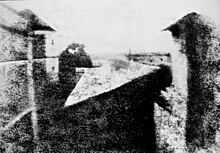History of photography
The first time someone thought of taking a "picture" was around 1800 but it wasn't successful until the mid 1820's when Nicéphore Niépce successfully captured an image but it took days to capture and the turn out was very crude. Louis Daguerre, Niépce's associate developed the daguerreotype process, the first publicly announced photographic process. this process was much faster only taking several minutes to capture and produced clear fine detailed results. this process was commercially introduced in 1839, the birth year of photography. it wasn't long before this process had some competition, the calotype negative and the salt print process invented by Henry Fox Talbot. subsequent innovations drastically reduced the time it took to capture a photo from minutes to seconds down to a small fraction of a second.This is the earliest surviving camera photograph, taken in 1826,

when Niépce died suddenly at age 34 all his notes were left for Daguerre, being more interested in silver based processes than Niépce he carried on researching. on 7 January 1839, the first complete practical photographic process was announced at a meeting of the French Academy of Sciences.
Color photography
color photography was the main goal from the very beginning, but it was a very difficult task to accomplish. Results were demonstrated by Edmond Becquerel as early as 1848, but exposures lasting for hours or days were required and the captured colors were so light-sensitive they would only bear very brief inspection in dim light. The first durable color photograph was a set of three black-and-white photographs taken through red, green and blue color filters.photography revolutionized
computer-based electronic digital cameras were introduced in the 1990's, these revolutionized photography. traditional film based photography was slowly taken out by the better quality and lowering prices of the digital cameras.
No comments:
Post a Comment